
Brigham Young University
BYU ScholarsArchive
Theses and Dissertations
2022-04-19
Outdoor Air Pollution and Psychological Well-Being: A Meta-
Analysis
Jeremy Stanley Bekker
Brigham Young University
Follow this and additional works at: https://scholarsarchive.byu.edu/etd
Part of the Family, Life Course, and Society Commons
BYU ScholarsArchive Citation
Bekker, Jeremy Stanley, "Outdoor Air Pollution and Psychological Well-Being: A Meta-Analysis" (2022).
Theses and Dissertations. 9470.
https://scholarsarchive.byu.edu/etd/9470
This Thesis is brought to you for free and open access by BYU ScholarsArchive. It has been accepted for inclusion
in Theses and Dissertations by an authorized administrator of BYU ScholarsArchive. For more information, please
contact ellen_amatangelo@byu.edu.

Outdoor Air Pollution and Psychological Well-Being: A Meta-Analysis
Jeremy Stanley Bekker
A thesis submitted to the faculty of
Brigham Young University
in partial fulfillment of the requirements for the degree of
Master of Science
Jared S. Warren, Chair
Scott A. Baldwin
Benjamin W. Abbott
Department of Psychology
Brigham Young University
Copyright © 2022 Jeremy Stanley Bekker
All Rights Reserved

ABSTRACT
Outdoor Air Pollution and Psychological Well-Being: A Meta-Analysis
Jeremy Stanley Bekker
Department of Psychology, BYU
Master of Science
Human life takes place as part of a global ecosystem, meaning that human mental health
is at least partially tied to the health of the planet. Health experts who seek to promote
psychological well-being should consider how changes to the broad ecological system may
impact their efforts. Given the potential impact of the environment on human well-being, we
conducted a meta-analysis to assess the impact of air pollution on subjective well-being. The
goal of this project was to outline the current state of the research on these constructs and
provide a clear framework for what research is still needed. Nonsignificant relationships were
found for six out of seven of the measured pollutants. Overall, these results appear to indicate a
nonsignificant negative relationship between our constructs; however, our model had significant
heterogeneity which may impact the validity of these findings. Attempts to reduce statistical
heterogeneity demonstrated the importance of complex measurement and study design when
studying the impact of ecological environments on well-being.
Keywords: Subjective well-being, air pollution, life satisfaction, ecopsychology

ACKNOWLEDGEMENTS
I would like to acknowledge the help of all my mentors who made this project possible. I would
also like to thank Ed Diener for dedicating his life to the study of well-being. Thank you to my
statistics team, Scott Baldwin, Brinley Zabriskie, Matt Heaton, and Chongming Yang. Scott
Baldwin is owed a special thank you for his membership on my committee, his willingness to
read over my manuscript and for being the backbone of my statistical training. Scott has a deep
knowledge of his work, and I am very grateful for his willingness to share that knowledge with
me. Ben Abbott also deserves a special thank you for his membership on my committee, for
reading over this manuscript and for his endless optimism and kindness. After each conversation
I have with Ben I am left with a renewed hope for the world. I would like to thank my mentor
Jared Warren for shaping me from a young freshman to the graduate student I am today. Jared’s
endless patience, support, and wisdom has helped me achieve every one of my academic goals,
and I would not be who I am today without his mentorship. I owe a great deal to each of the
mentors who have given so much of their time; it is a gift I hope to never forget. Finally, I
dedicate this thesis to my wonderful wife Kate and to my cat, Frances

TABLE OF CONTENTS
TITLE .............................................................................................................................................. i
ABSTRACT.................................................................................................................................... ii
ACKNOWLEDGEMENTS ........................................................................................................... iii
TABLE OF CONTENTS............................................................................................................... iv
LIST OF TABLES ......................................................................................................................... vi
LIST OF FIGURES ...................................................................................................................... vii
Introduction..................................................................................................................................... 1
The Impact of Air Pollution on Human Health .............................................................................. 2
The Impact of Air pollution on Psychological Well-being............................................................. 4
Present Study ................................................................................................................................ 10
Hypotheses .................................................................................................................................... 11
Method .......................................................................................................................................... 11
Review and Selection Criteria ...................................................................................................... 11
Organizational Framework ........................................................................................................... 13
Data Collection and Extraction ..................................................................................................... 13
Study selection and retrieval ..................................................................................................... 13
Data Extraction.......................................................................................................................... 14
Data coding ................................................................................................................................... 15
Study Quality Assessment ............................................................................................................ 18
Data Analytic Procedure ............................................................................................................... 20
Results........................................................................................................................................... 21
iv

Study Characteristics .................................................................................................................... 21
Influence Analysis ........................................................................................................................ 22
Main Analysis ............................................................................................................................... 24
Is there a statistically significant negative relationship between increased ambient air pollution
exposure and life satisfaction? .................................................................................................. 24
Moderating Analysis ..................................................................................................................... 26
Heterogeneity Assessment ............................................................................................................ 27
Publication Bias ............................................................................................................................ 28
Discussion ..................................................................................................................................... 30
Limitations .................................................................................................................................... 31
Future research.............................................................................................................................. 32
Conclusion .................................................................................................................................... 33
References..................................................................................................................................... 35
v

LIST OF TABLES
Table 1. Study Information ........................................................................................................... 16
Table 2. Study Quality Assessment .............................................................................................. 19
vi

LIST OF FIGURES
Figure 1. PRISMA Flow Diagram ...................................................................................................15
Figure 2. Leave-one-out analysis.....................................................................................................23
Figure 3. Forest Plot ......................................................................................................................25
Figure 4. Funnel Plot .....................................................................................................................28
Figure 5. Galbraith Plot..................................................................................................................29
vii

Outdoor Air Pollution and Psychological Well-Being: A Meta-Analysis
All of human life takes place as part of a global ecosystem: humans depend on the natural
world for a livable climate, edible food, and breathable air (Y. Li et al., 2018; Romanelli et al.,
2015). An adequately safe environment is necessary for human flourishing to be possible at the
societal scale, which means that human mental health is in some ways tied to the health of the
planet (Lomas, 2015; Nurse et al., 2010) Thus, psychologists and other health experts who seek
to promote psychological well-being should consider how changes to the broad ecological
system may impact their efforts (Berry et al., 2018). In 2015, the United Nations set out a global
resolution with 17 sustainable development goals to support “people, planet, and prosperity”
(Assembly, 2015). Included in this resolution were goals to promote health and well-being (goal
3) and to protect and restore global ecosystems (goal 15) (Assembly, 2015, p. 14). Human health
is dependent on a stable climate, clean air and water, and food security; and natural ecosystems
that provide these services are often damaged by problematic human behavior, therefore
promoting human health and protecting natural ecosystems are complementary objectives (Nurse
et al., 2010; Romanelli et al., 2015). To accomplish the sustainable development goals outlined
above, research must address how alterations in global ecosystems may be impacting
psychological functioning, and how human behaviors are impacting natural ecosystems.
The idea that individuals can achieve a meaningful and satisfying life is a core tenant of
most modern societies, and yet policy makers often fail to consider how policy decisions will
impact the well-being of citizens (Odermatt & Stutzer, 2017; Turner, 2018). Instead, much of
public policy is currently guided by increasing gross domestic product (GDP), which is only
1

associated with higher subjective well-being in poor countries while increases tend to plateau for
rich countries (Proto & Rustichini, 2013). Subjective well-being measurement has been put
forward as an alternative method to assess the progress of societies, with the severity of various
environmental and social stressors measured against their impact on subjective well-being.
This thesis will focus specifically on the link between subjective well-being and outdoor
air pollution using a systematic review and meta-analysis in order to understand how this
environmental stressor impacts subjective well-being on a global scale. Researchers,
psychologists, and policy makers would benefit from a big picture report on the connection
between air pollution and well-being in order to address both of them more effectively.
The Impact of Air Pollution on Human Health
Air pollution as an important human health issue first entered the public psyche during
the great smog of London in the 1950’s which killed up to 12,000 people (Polivka, 2018). This
event, along with other pollution disasters in the 1950’s led to important air pollution reform,
particularly in regard to limiting concentrations of sulfur dioxide which is responsible for acid
rain (Stern & Professor, 1982). However, despite the success of these early efforts, ambient air
pollution still causes more than nine million deaths annually (Burnett et al., 2018; Errigo et al.,
2020; Lelieveld et al., 2019; Stern & Professor, 1982).
Ambient air pollution impacts physical health both acutely and chronically, with the
health effect depending on the chemical make-up, size, and concentration of the particle.
Understanding the physical health effects of air pollution is important because decreases in
physical health may be a potential mediator between air pollution and subjective well-being (F.
2

Li & Zhou, 2020). Specific pollutants including Carbon monoxide (CO), Nitrogen oxides (NOx),
Sulfur dioxide (SO2), Ozone (O3), and other micro pollutants have significant impacts physical
health: these compounds largely build up as a result of the burning of fossil fuels and have been
linked to increases in respiratory and cardiovascular disease, lung cancer, and all-cause mortality
(Almetwally et al., 2020; Faustini et al., 2014; Kim et al., 2013; Meng et al., 2003; Robertson,
2006). Particulate matter (pm, pm10, pm2.5) is a mixture of every particle in the ambient air that
humans breath: pm particles are classified by their diameter (pm10 = 10 μm, pm2.5= 2.5 μm,
ultrafine pm= .01 μm) (Almetwally et al., 2020). The health effects of Pm2.5 particulates are
more severe than larger molecules as they are small enough to reach the bronchial capillary wall
in the lungs (Almetwally et al., 2020; World Health Organization, 2014). Overall, air pollution
has a significant and well documented effect on physical health.
Along with the health effects of air pollution on physical health, the psychological effects
of air pollution have also received considerable research attention. This research generally
indicates that increased levels of PM, NO2, and SO2 are associated with poor mental health and
the aggravation of existing mental disorders, although most of the current research has not
sufficiently accounted for alternative explanations such as seasonality, medical difficulties, or
wind direction (Buoli et al., 2018). These negative psychological effects are hypothesized to be a
result of fine and ultra-fine particles’ impact on the central nervous system (CNS) and cognitive
systems (Buoli et al., 2018; Calderón-Garcidueñas et al., 2015; Gu et al., 2020). The exact
mechanisms of neurodegeneration are not well-known but are likely related to
neuroinflammation and oxidative stress (Calderón-Garcidueñas et al., 2015). Along with the
3

physiological components of the air pollution/mental health interaction, there are also thought to
be psychosocial components as well. Increased air pollution has been associated with decreased
physical activity, which in turn has been associated with decreased mental health—thus
decreased physical activity may mediate the relationship between the two variables (An et al.,
2018; Tainio et al., 2021; Yang et al., 2021). Overall, air pollution has been associated with
decreased mental health although the exact mechanisms for this relationship still deserve
research attention and more alternative explanations for the association need to be ruled out.
The Impact of Air pollution on Psychological Well-being
An important component of mental health is subjective well-being, yet there is only a
small body of research on the connection between air pollution and subjective well-being
(Lomas, 2015; Nurse et al., 2010). Subjective well-being can be defined as either the subjective
experience of positive emotional states (hedonic well-being) or the subjective experience of
meaning and purpose (eudemonic well-being) (Henderson & Knight, 2012). Researchers may
question why subjective well-being is worth studying as a construct given that it is a subjective
evaluation measure rather than an objective indicator of happiness and prosperity; however, how
individuals in a society personally view their subjective well-being (their personal ability to find
joy and meaning in their life) may be an equally important indicator of the success of that society
as objective measures of societal success such as GDP (Diener et al., 2018). The idea that well-
being is a better indicator of societal success is particularly important when studying a topic like
air pollution where personal beliefs about the well-being impact of air pollution are likely to
change an individual’s desire to mitigate that problem (Chen et al., 2019; Diener et al., 2018).
4

Although improvements in well-being are associated with lower all-cause mortality and a
variety of other positive outcomes, improving population well-being may also be worthwhile in
its own right as most individuals strive to experience meaning and joy in their own lives (Adler
& Seligman, 2016; Bryndin, 2017; Martín-María et al., 2017). Diener et al (2018) specifies
several main reasons for why subjective well-being is worth tracking on a global scale. First of
all, tracking subjective well-being may help elucidate societal differences in quality of life: in
regard to the current paper, measuring subjective well-being differences due to air pollution can
help clarify the impact that air pollution is having on overall quality of life. Second, citizens
highly value subjective well-being. Given that people want to live happy and fulfilling lives,
measuring how air pollution is impacting their ability to do that will help encourage air pollution
mitigation efforts (Diener et al., 2018).
A core goal of clinical psychology and science in general is to reduce suffering and
improve quality of life for all people; understanding the impact air pollution is having on
psychological well-being may help achieve that goal. In order to understand the relationship
between subjective well-being and air pollution, it is important to assess the current state of the
literature on these constructs.
This body of research is largely based on subjective well-being reports via national and
international surveys correlated with air pollution levels at the time of the report, a method
termed the life-satisfaction approach (Welsch, 2002). This research was originally created as a
method of environmental evaluation to calculate the economic cost of air pollution on well-
5

being. This paper will focus on clarifying the impact of air-pollution on well-being without
making arguments about environmental market valuation.
Current research suggests a negative relationship between subjective well-being and
increased ambient air pollution (Y. Li et al., 2018; Lu, 2020). These results have been found
across pollutant type and geographical areas as noted in Li et al.’s (2018) review. Effects of
pollution on SWB are not the same across groups, with older people and younger people being
impacted more severely (Luechinger, 2010; Menz & Welsch, 2012). Along with physical
measurement of air pollution, perceptions of air pollution have also been measured; in these
studies, higher perception of air pollution is correlated with lower subjective well-being, this
relationship is stronger for wealthier individuals and individuals who hold pro-environmental
views (Ferrer-i-Carbonell & Gowdy, 2007; Hart et al., 2018; F. Li & Zhou, 2020; Rotko et al.,
2002).
Despite the previous findings suggesting a negative impact of air pollution on well-being,
several measurement problems inhibit conclusive findings, particularly because it is hard to
match exact air pollution exposure on the individual level and because air pollution likely
impacts individuals differently depending on their personal health history and beliefs about air
pollution risks (Li et al., 2018; Lu, 2020). Therefore, matching individual exposure and
recognizing heterogeneity in effects is particularly important. My thesis will seek to assess the
severity of this problem by assessing the spatiality, temporality, and geographical location of air
pollution measurement. We will reduce heterogeneity in our analysis by only including within
country analyses.
6

Altering subjective well-being in the long-term (either negatively or positively) is
difficult, which may lead some to wonder how air pollution could have a long-lasting impact on
subjective well-being. Due to hedonic adaptation, people tend to return to a base level of
happiness regardless of life circumstances. Even after large life events like getting married or
winning the lottery people tend to return to their normal level of happiness after a relatively short
period of time (Perez-Truglia, 2012). However, hedonic adaptation is a complex construct with
many potential mechanisms and exceptions: individuals may adapt to changing life
circumstances by increasing coping strategies, recontextualizing life circumstances, or by
altering personal characterizations of happiness (Klausen et al., 2021). Given the complexity of
the construct, avoiding promoting societal well-being based on the idea that people will return to
their base level of happiness is both ill-conceived and unethical (Huang, 2018; Klausen et al.,
2021).
Air pollution may be a construct that resists hedonic adaptation due to its gradual and
varying impact on physical health and life opportunities, thus the continued impact of air
pollution on well-being may depend on the specific characteristics of the individual and the
environment (their personal valuation of air pollution, cultural adaptability, and person risk
assessment) (Menz, 2011). Thus, for air pollution to significantly contribute to loss of well-being
and happiness it would need to contribute a consistent but variable impact on life satisfaction.
There are several mechanisms that may contribute to this loss in satisfaction. The first
relates to perceptions of air pollution, with the theory being that individuals experience decreases
in life satisfaction and positive emotional states when they believe the air quality is poor (Du et
7

al., 2018; Y. Li et al., 2018). A second potential process by which air pollution may impact SWB
is through physical health, with physical health difficulties caused by air pollution leading to
lower well-being (F. Li & Zhou, 2020). The final potential mechanism for air pollution to impact
well-being is through lost engagement in meaningful life activities including physical exercise,
and nature exposure (Chang et al., 2019; Wang et al., 2020).
Two systematic reviews of air pollution and subjective well-being data have already been
conducted, although these reviews do not assess the overall between studies effect size or include
comprehensive review criteria (Y. Li et al., 2018; Lu, 2020). Lu ‘s (2020) review assessed the
overall psychological, economic, and social effects of air pollution and found a consistent effect
for air pollution on life-satisfaction and happiness; however, this study failed to address specific
differences in study design, did not address the quality of study design, did not include review
search criteria, and did not offer comprehensive recommendations for future research. Li’s
(2018) review on subjective well-being and air pollution more thoroughly assessed the impact of
air pollution on subjective well-being, with a more comprehensive focus on the measurement,
drivers, and outcomes of the current subjective well-being research. This study found consistent
negative relationships between subjective well-being survey data and several pollutants,
highlighted the difficulty of conducting high quality air pollution survey data, and recommended
psychophysical research design as an alternative method. While this study addressed the
difficulties of conducting survey well-being data, it did not systematically identify the quality of
the current well-being data. It also did not include review search criteria and did not offer
comprehensive recommendations for future research (Borenstein et al., 2021). Although
8

published systematic reviews have contributed meaningfully to the current body of well-being
research, more detailed reviews are needed that assess differences in study design, assess quality
of data, and include comprehensive review criteria.
Along with a need for a more comprehensive systematic review, available research has
also not addressed the meta-analytic effect of air pollution on subjective well-being. Meta-
analytic reviews add important incremental value to systematic reviews by providing a
synthesized overall effect size for the relationship (Borenstein et al., 2021). Non-meta-analytic
reviews generally rely on statistically significance of individual studies to form conclusions
about the quality of findings: however, this approach fails to analyze the clinical importance of
effects and is prone to bias due to type 1 error and low power (Cheung & Lucas, 2014; Cooke et
al., 2016; Kahneman et al., 2004). Meta-analytic research would be particularly useful for air
pollution and well-being research as this field generally has small effect sizes which leads to
increases in bias. Furthermore, meta-analytic analysis in this area could help explorer how
temporal or spatial level of study analysis influences the effect between variables.
A final limitation in current well-being research relates to subjective well-being and air
pollution measurement—currently there is poor consistency about the best length of well-being
measures, and type of well-being construct measured. Subjective well-being is typically
measured through a single item or multi-item self-report measure. Single-item measures have
been shown to have similar construct validity to longer measures, although they are also prone to
bias (Barrington-Leigh & Behzadnejad, 2017). This meta-analysis will help determine if current
approaches to well-being measurement are providing a consistent measure of the impact of air
9

pollution on well-being by assessing the relationship between well-being and air pollution on
different temporal scales.
Present Study
Overall, measuring the impact of air pollution on subjective well-being is a promising
line of research with important psychological and environmental implications. Three important
areas need to be addressed to move forward effectively with air pollution and well-being
research: 1. A systematic review that specifically focuses on future research needs, 2. A meta-
analysis of air pollution effects in order to assess overall air pollution impact based on type of
pollutant and in order to assess heterogeneity between studies, and 3. A general discussion and
consensus on the best way to move forward with well-being and air pollution measurement. This
study sought to address all three limitations through a systematic review and meta-analysis using
the PRISMA guidelines for reviews (Page et al., 2021).
This study will seek to clarify the current research on air pollution and psychological
well-being in order to promote more effective research and solutions by 1. calculating the across
studies impact of air pollution, 2. determining how study design and type of pollutant influence
the relationship between air pollution and well-being, and 3. Providing a clear idea of what
research is needed in the future. Specifically, this systematic review will outline the state of the
current research and discuss problems and solutions for calculating accurate correlation and
causation for hypothetical psychological constructs such as well-being in complex ecological
environments. To reduce heterogeneity and endogeneity the present study excludes all subjective
well-being constructs besides life satisfaction in the meta-analysis.
10

Hypotheses
1.
Across studies, life satisfaction will have a significant and meaningful negative
relationship with both invisible and visible air pollution as indicated by a statistically significant
beta (95% confidence interval does not include zero).
2.
The effect of air pollution on wellbeing will be significantly larger on both
smaller temporal scales and smaller spatial scales, with the mean beta on smaller scales falling
below the 95% confidence interval of larger scales.
3.
The effect of air pollution on well-being will differ significantly depending on the
geographical region with higher beta in Asia than in other regions as indicated by the mean
geographical region falling outside of the other region’s 95% confidence intervals.
4. The effect of air pollution on well-being will differ significantly depending on the type
of pollutant.
Method
Review and Selection Criteria
We conducted a systematic review and meta-regression to synthesize the result of related
studies and identify the aggregated slope coefficient between studies (Standardized Beta = across
studies relationship between one standard deviation increases of objective air pollutants on
standard deviations of subjective life-satisfaction report). The formula for standardized beta was
B = β*x/y where x = the standard deviation of air pollution and y = the standard deviation of life
satisfaction for a specific study as suggested by (Palmer & Sterne, 2016).
11

Error was computed by dividing the square root of the standardized beta coefficient by the
square root of sample size (Lee et al., 2015).
Inclusion and exclusion criteria are outlined below.
● Population—Studies including general adult populations (≥18 years of age)
● Exposures — Studies of outdoor particles with mass < 10 μm in aerodynamic diameter
(PM10) and outdoor particles < 2.5 μm in aerodynamic diameter (PM2.5), as outlined in
(Braithwaite et al., 2019).
● Outcomes — studies had to be correlated with subjective measures of life satisfaction.
● Studies were peer reviewed and had to be published in a scientific journal
● Design — studies had to use a cross comparison or time series design
We excluded studies meeting the following descriptions:
● Design — correlation between life satisfaction and air pollution was measured between
countries rather than within countries.
● Population —studies that assessed special populations (i.e., not a general adult sample)
● Exposures — studies that did not include observed air pollution exposure in natural
environments (i.e., perceived risk of exposure, laboratory experiments)
● Outcomes —studies that used other methods for measuring subjective well-being.
We only included life-satisfaction in our meta-analysis due to heterogeneity problems
associated with comparing different research designs and well-being variables. With studies that
included other questions related to well-being and air pollution, we analyzed only the data
regarding objective air pollution exposure and life-satisfaction. To avoid bias we checked for
12

studies that were not written in English but did not find any. Studies that measured multiple
pollutants simultaneously were included, which is feasible because meta-regression relies on
individual beta coefficients rather than overall effect size. Therefore, we did not have to collapse
data within studies. Studies were grouped together based on the type of pollutant assessed.
Organizational Framework
Both the systematic review and meta-analysis in this study were conducted and reported in
accordance with the PRISMA guidelines (Borenstein et al., 2021), and a published guide to
conducting meta-analyses (Schiavo, 2019). We were, however, unable to pre-register our study
because new PROSPERO guidelines prevent registration after any data have been collected
rather than before data extraction is complete (Palmer & Sterne, 2016). We had already started
collecting data when we attempted to preregister our study because we did not realize that
guidelines had changed.
Data Collection and Extraction
Study selection and retrieval
To identify studies which fit inclusion criteria we used the following electronic databases:
EBSCO, Psych INFO, Web of Science, Academic search premier. We used the following criteria
to identify pertinent studies and filter out irrelevant studies: Keywords: “Well-being”
“Psychological Well-being” “Subjective well-being” “Eudemonic Well-being” “Hedonic Well-
being” “Life Satisfaction”; and “Pollution” “Air Pollution”; and “pm2.5” “pm10” “so2”
“particles” “api” “aqi” “03” “no2”. We accessed these databases through Brigham Young
13

University’s library website. We also checked google scholar for pertinent articles. The last
search query was conducted on November 30th, 2021. We did not use a review protocol.
Data Extraction
The primary author aggregated the studies using a pre-prepared google doc template with the
following terms: type of subjective well-being construct, mean and standard deviations of both
well-being and air pollution data, sample size, research design, type of pollutant, spatial spread
of research, temporal spread of study, beta coefficient, and standard error. The completed
spreadsheet along with excluded studies are available on our OSF report:
https://osf.io/7s96e/?view_only=8cce213e37604a9f9dcc67d7b18092be. The studies were then
double checked by a research assistant, Across the study we found 37 inconsistencies which
translated into an overall interrater reliability of 86%. All inconsistencies were resolved by the
primary author. Given that only cross comparison studies were included, there was no need to
transform beta coefficients. In order to accurately measure the relationship across studies we
standardized beta coefficients by multiplying the coefficient by the standard deviation of the x
and y variable (standard beta = beta*xsd/ysd) as recommended by Palmer & Sterne (2016). We
calculated standard errors based on sample size and beta coefficient and then used these results
for the meta-regression (Standard Error = sqrt of standardized beta/sqrt of sample size).
We collected data from 17 of which also met criteria for the meta-regression. To assess
risk of publication bias we used a funnel plot (STATA command: metafunnel). To see a flow
chart of our data extraction results, view the PRISMA chart below.
14
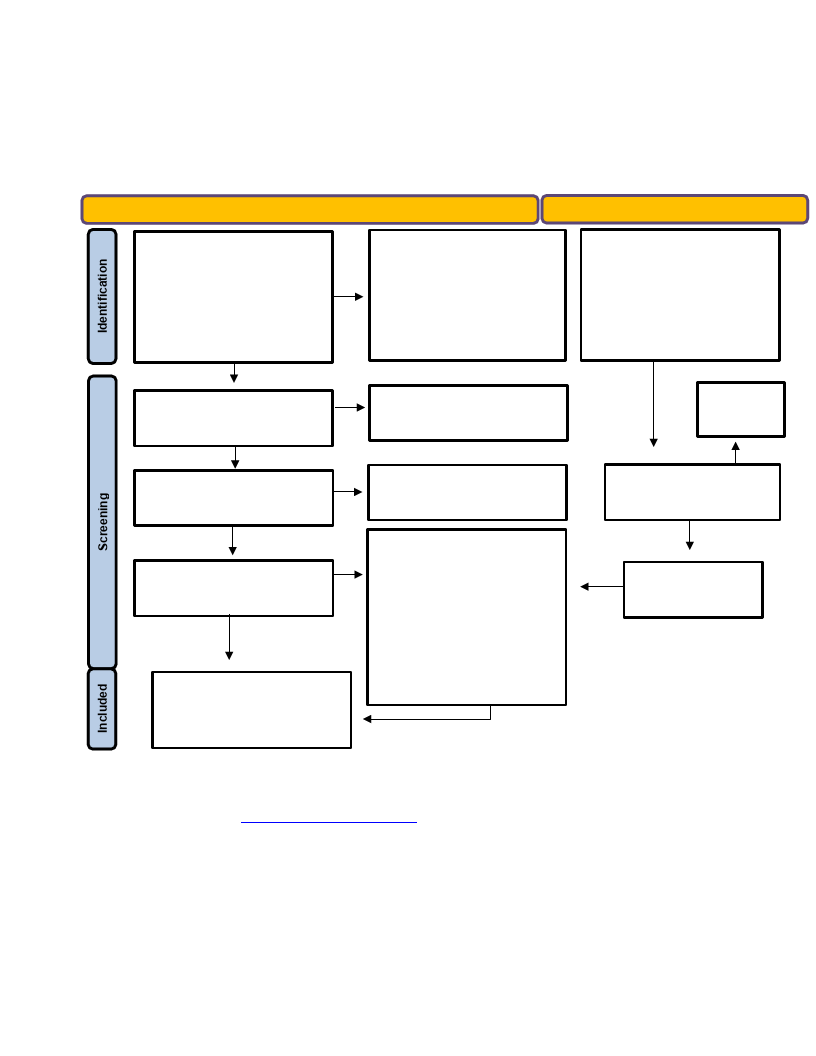
Figure 1. PRISMA Flow Diagram
PRISMA 2020 flow diagram for new systematic reviews which included searches of
databases, registers, and other sources
Identification of studies via databases and registers
Identification of studies via other
Records identified from:
PsycArticles, Academic Search
Premier, Academic Search
Ultimate, APA psychinfo,
Medline)
Databases (n = 218)
Records removed before
screening:
Duplicate records removed
(n = 122)
Records identified from:
Citation searching (n = 129)
Records screened
(n = 96)
Records excluded
(n = 0)
Reports not
retrieved
(n = 0)
Reports sought for retrieval
(n = 96)
Reports not retrieved
(n = 96)
Reports sought for retrieval
(n = 129)
Reports assessed for eligibility
(n = 96)
Studies included in review
(n = 17)
Reports of included studies
(n = 17)
Reports excluded:
Other WB construct (n = 23)
No direct SWB measurement
(n = 97)
No direct air pollution
measurement (n= 24)
Special Population (n = 5)
Between country comparison
(n = 11)
Incompatible methods (n = 8)
Indoor pollution (n = 33)
Reports assessed for
eligibility
(n = 129)
From: Page MJ, McKenzie JE, Bossuyt PM, Boutron I, Hoffmann TC, Mulrow CD, et al. The PRISMA 2020
statement: an updated
guideline for reporting systematic reviews. BMJ 2021;372:n71. doi: 10.1136/bmj.n71.
For more information, visit: http://www.prisma-statement.org/
Data coding
For the meta-analysis we coded well-being construct, study design, life satisfaction
questions, mean and standard deviation of all pollutants, mean and standard deviation of life-
15

satisfaction, temporal and spatial level of study design, sample size, type of air pollutant, beta
coefficients, standard error, geographical region, and year published. We only sought data that
included both subjective life satisfaction questions and objective air pollution measurement. For
studies that included multiple equations with differing control variables we only included the
result that included all controls. Coding for meta-analysis was checked for inconsistencies by a
second reviewer, and any inconsistencies found were noted and resolved by the primary author.
Two inconsistencies were found and corrected.
In our analysis there was only one missing data point. We contacted the author of this
study and he responded with the missing information along with his STATA code for replication.
Therefore, missingness impacting study results was not a concern for our meta-analysis.
Table 1. Study Information
Study
Tempor Spatial Air
Geogra Year Main Findings (*denotes
al level Level Pollutants phical Publis significance at the .01
of air of air
Region hed level, **denotes
pollutio pollutio
significance at the .005
n
n
level, and *** denotes
reportin reporti
significance at the .001
g
ng
level)
(Ahumada & Iturra, Yearly
2021)
(Barrington-Leigh Daily
& Behzadnejad,
2017)
(Dolan & Laffan, Yearly
2016)
City PM2.5
South 2021 Negative impact for PM2.5
Americ
(B = -.00591**)
a
Region PM2.5, North 2016
No2, So2, Americ
Co
a
Non-significant impact for
all pollutants except So2
which had had a negative
impact (PM2.5 B = -.0002,
CO B = .0291, No2 B =
.000074, So2 B = -.0053*)
Region PM2.5
Europe 2016 Negative impact with
PM2.5 (B = -0.0181***)
16

(Dong et al., 2018) Yearly House PM2.5
Asia 18-Feb Negative impact with
PM2.5 (B = -0.05**)
(Du et al., 2018)
Daily
House PM2.5, Asia
PM10,
No2, So2
2018
Negative impact for all
pollutants in Beijing (SO2
= -.0109***, NO2 =
−0.00612***, PM10 =
−0.00612***, PM2.5 =
−0.00283**) Negative
impact for So2 and No2
(So2 = −0.0125** and No2
= -.00513**) but not
PM10 and PM2.5 (PM10 =
-.00184, PM2.5 = -.00245)
for Shanghai Residents.
(Ferreira & Moro, Yearly Region So2
2010)
Europe 2013 negative impact with So2
(B = −0.016*)
(Ferreira & Moro, Yearly Region PM10
2010)
Europe 2010 Negative impact with
PM10 (B = -0.043**)
(Goetzke & Rave,
2015)
Yearly
Region Aggregate Europe 2015 Negative impact with
aggregate measure (B = -
0.14**)
(Guo et al., 2021)
Quarterly Region Aggregate, Asia
PM10, Co
2021
Negative impact for CO
but not PM10, and AQI
(CO B = -0.1759**, PM10
B = -0.0038, AQI B = -
0.0023)
(Liu & Hu, 2021)
Yearly
Region Aggregate, Asia
PM10,
No2, So2
2021
Negative impact for all
pollutants (CO B =
−0.0831**, No2 B = -
0.1806***, PM10 B = -
.2552***, AQI B = -
.3179***)
(Liu & Hu, 2021)
Yearly
House Aggregate, Asia
PM2.5,
PM10, So2
2021
Negative Impact for all
pollutants (So2 B = -
.317**, PM 10 B = -.164*,
AQI B = -0.284* PM2.5 B
= -0.289*)
17

(Schmitt, 2013)
Daily,
yearly
(MacKerron &
Mourato, 2009)
Yearly
(Mendoza et al.,
2019)
Yearly
(Smyth et al., 2011) Yearly
(Luechinger, 2009) Yearly
(Shi & Yu, 2020) Yearly
(Yuan et al., 2018) Daily
City No2, OZ, Europe 2013 Negative impact for O3
CO
but no other pollutants (O3
B = -0.0015*, CO B = -
0.0239, No2 B = -0.0010)
House PM10,
No2
Europe 2009
Negative impact for No2
but not PM10. (No2 B = -
0.042*,
PM10 B = -0.087)
Region PM2.5,
PM10
South 2019
Americ
a
Negative impact for both
pollutants (PM10 B = −
0.0021*, PM2.5 B = −
0.0045**)
City Aggregate, Asia 2011 Negative impact for both
So2
pollutants (Aggr B = -
0.001**, So2 B = -.002**)
Region So2
Europe 2009 Negative impact for So2
(B = -.005**)
City PM2.5
Asia 2020 Negative impact for PM2.5
(B =-.448***)
Region Aggregate Asia 2018 Negative impact for
aggregate (B = .0057**)
Study Quality Assessment
To assess for study quality, we used the OSQE for cross sectional studies (Drukker et al.,
2021). This is a newly optimized quality criteria list specifically built for observational studies. A
check on internal validity required assessment of both IV and DV with established measures and
adequate control of confounds (i.e., controlled for at least age, income, and health). A check on
external validity required including information about generalizability of results. A check on
representativeness required inclusion of information about sample characteristics that
demonstrated how the sample was representative. A check on IV required direct assessment of
18
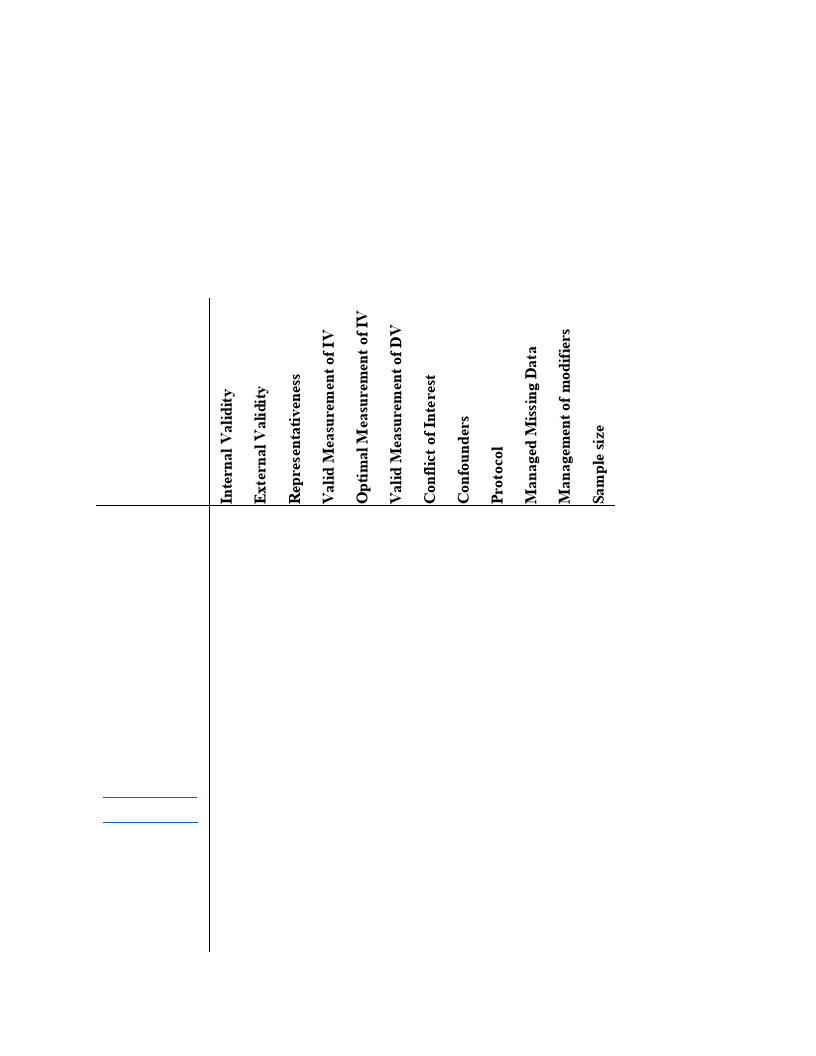
air pollution on at least the regional level, and a check on the DV required at least a single item
life satisfaction self-report question. Optimal measurement of IV required measurement of
pollution on the individual level at multiple time points. Finally, management of modifiers
required adequate assessment of both endogeneity and multicollinearity.
Table 2. Study Quality Assessment
Study
Ahumada &
Iturra (2021).
Barrington-
Leigh &
Behzadnejad
(2017)
Dolan & Laffan
(2016)
Dong et al.
(2018)
Du et al. (2018)
Ferreira et al.
(2013)
Ferreira et al.
(2010)
Goetzke & Rave
(2015)
Guo et al. (2021)
Liu & Hu (2021)
Liu et al. (2021)
Schmitt (2013)
MacKerron &
Mourato (2009)
Mendoza et al.
(2019)
19

Smyth et al.
(2011)
Luechinger
(2009)
Shi & Yu (2020)
Yuan et al.
(2018)
Study quality assessment tool OSQE for cross sectional studies (Drukker et al., 2021)
Our study quality assessment (Figure 2) indicated broad difficulties with external
validity, optimal measurement of air pollution, and problems with managing missing data and
modifiers. The studies included did not demonstrate how their results would be representative of
broader populations and did not assess air pollution with enough specificity. They also did not
properly control for shared collinearity between independent variables and error terms.
Data Analytic Procedure
We analyzed the overall beta coefficient using Stata command: metareg, where beta
indicated the across study slope coefficient weighted by sample size using a random effects
design (Harbord & Higgins, 2008). To explore whether temporality or spatiality impacted the
relationship between variables, we dummy coded studies based on their spatial and temporal
characteristics. Spatial levels were regional, city, and house relating to whether comparisons
were computed on the regional, city, or household level. Temporal levels were annual, quarterly,
and daily, which related to whether studies measured pollution on the daily, quarterly, and
annual level. We separated results by pollutant type using the STATA by command. We decided
to compute separate meta-regressions for each pollutant type individually (rather than including
them as moderators) as spatial and temporal relationships between variables likely depend on the
pollutant in question.
20

To assess for total variation due to heterogeneity rather than chance we used the I2 value,
and then explored reasons for heterogeneity using subgroup analysis. The meta-regression study
design allowed for accurate assessment for contributions of heterogeneity due to spatiality,
temporality, and geography of data. We also used the Stata leaveoneout command to assess
impacts of individual studies on heterogeneity.
Results
Study Characteristics
We extracted data and beta effects from 17 studies examining the relationship between air
pollution and subjective report of life satisfaction. Robumeta controls for interstudy dependent
effects by relaxing assumptions of normality (Hedges et al., 2010). Separately we also analyzed
studies by type of pollutant which automatically controlled for aggregate effects as each analysis
did not have multiple effect sizes from the same study. We also used standard error of the mean
rather than standard deviation units for the analyses in order to control for differing sample sizes.
The total sample size across all studies was 599,043. In regard to air pollution, these
studies included 7 aggregate effect sizes, 9 PM2.5 effect sizes, 8 PM10 effect sizes, 6 NO2 effect
sizes, 8 SO2 effect sizes, 1 O3 effect size, and 3 CO effect sizes. In regard to geographical
regions, these studies included 3 effect sizes from South America, 4 effect sizes for North
America, 10 effect sizes from Europe, and 25 effect sizes from Asia. In regard to spatial
measurement of air pollution, 4 effect sizes were calculated on the house level, 18 effect sizes
were calculated on the city level, and 20 were calculated on the regional level. Finally, in regard
to temporal measurement of well-being, 15 effect sizes were calculated on the daily level, 4
21

effect sizes were calculated on the quarterly level, and 23 were calculated on the annual level.
Overall, data was spread fairly evenly across pollutant types, and the majority of effects were
calculated in Asia at the regional level with annual life-satisfaction averages.
Influence Analysis
To assess the influence of individual studies on the overall effect we computed an
influence analysis. An influence or “leave-one-out” analysis helps assess whether individual
studies are responsible for large amounts of heterogeneity or effect (Baldwin & Shadish, 2011).
An influence plot was commuted using the Stata Meta forestplot, leaveoneout command. Figure
one outlines the result of this analysis.
22
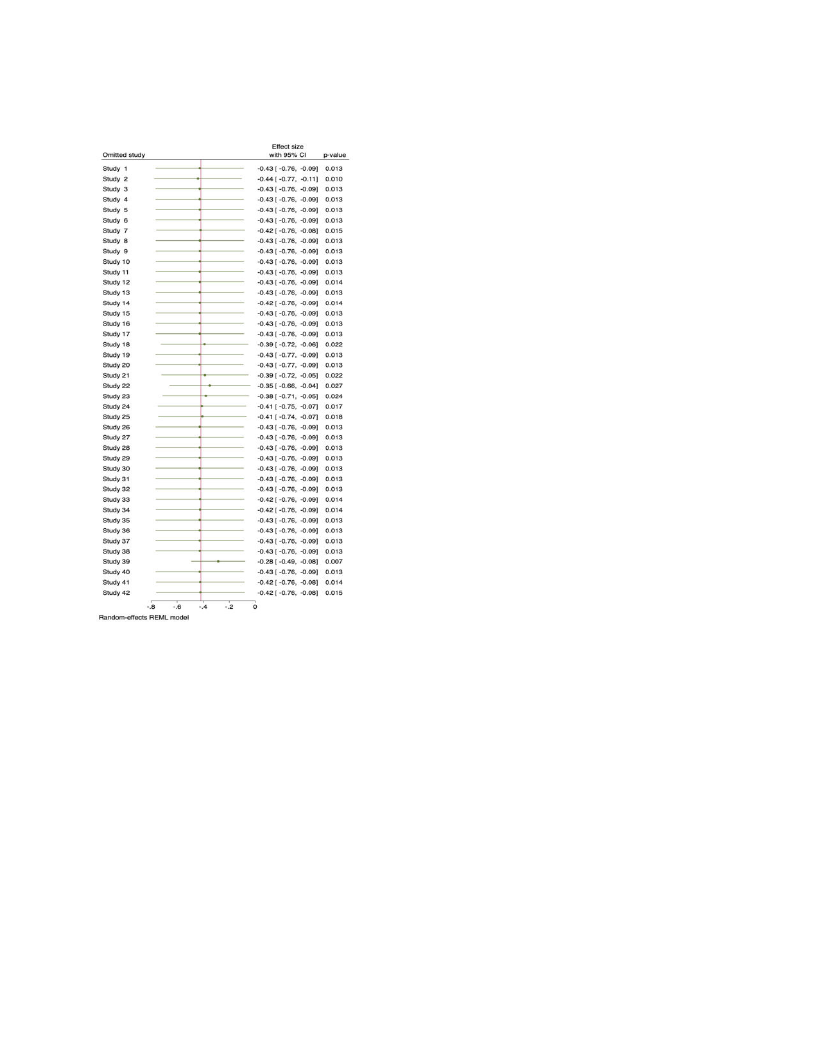
Figure 2. Leave-one-out analysis
Figure 2: An influence plot from a “leave-one-out” analysis. The red line indicates the overall
beta slope when all studies are included in the meta regression. The dots on the horizontal green
line indicate the overall beta slope when those studies are removed from analysis (Baldwin &
Shadish, 2011).
As indicated in figure 2., beta 39 (Shi & Yu, 2020) and beta 22-25 (Liu & Hu, 2021) had a large
net negative effect on the overall regression slope. Dropping these studies decreased the Chi2
statistic by 500% (Chi2 = 420,000 to Chi2 = 83160). Even with this reduction, overall
heterogeneity stayed extremely high (I2 = 100%, P > Q = .0000). We opted to remove both of
23

these studies from the overall analysis, given their large impact on study results and because they
dealt with endogeneity in a different way than all other studies which likely explains their larger
beta coefficient. We did not remove any other studies from the analysis because there was no
clear reason for their dismissal, and because removing further studies did not lead to a significant
decrease in the I2 value.
Main Analysis
Is there a statistically significant negative relationship between increased ambient air
pollution exposure and life satisfaction?
The overall regression coefficient for all pollutant types combined was nonsignificant (γ1
= -.17, 95% CI = -.35 to .02, p =.07). We ran a multiple regression by pollution type to prevent
inappropriately grouping of within study effect sizes. Nonsignificant relationships were found for
all five measured pollutants except the aggregated pollution beta coefficient. Aggregate survey γ1
= -.35, 95% CI = -.66 to -.04, p =.028. PM2.5 survey γ1 = -.073, 95% CI = -.48 to .34, p =.189.
PM10 survey γ1 = -.05, 95% CI = -.47 to 37., p =.167. No2 survey γ1 = -.07, 95% CI = -.47 to .39,
p =.242. SO2 survey γ1 = -.05, 95% CI = -.04 to .11, p =.161. CO survey γ1 = -.384, 95% CI = -
.92 to .152, p =.895. We could not compute an accurate effect size for OZ due to low sample size
(>3). Besides the aggregate pollution effect, these results appear to indicate a nonsignificant
negative relationship between subjective well-being and ambient air pollution, however, our
model had significant heterogeneity (Q = 83160, p < .001, I2 = 100%) which may explain the
nonsignificant findings as broad heterogeneity reduces statistical power (Baldwin & Shadish,
2011). The statistical significance of the aggregate pollution effect should be interpreted with
24

extreme caution due to the study’s high heterogeneity, and thus this result does not indicate
clinical significance. Furthermore, we found in exploratory analysis that dropping beta
coefficient 18 renders the aggregate effect nonsignificant (γ1= -.073, 95% CI = -.49 to -.34, p
=.196). According to this meta-regression, neither our first hypothesis nor our fourth hypothesis
were supported. In accordance with previous guidelines, we decided to analyze potential
moderating variables that may explain heterogeneity.
Figure 3. Forest Plot
25
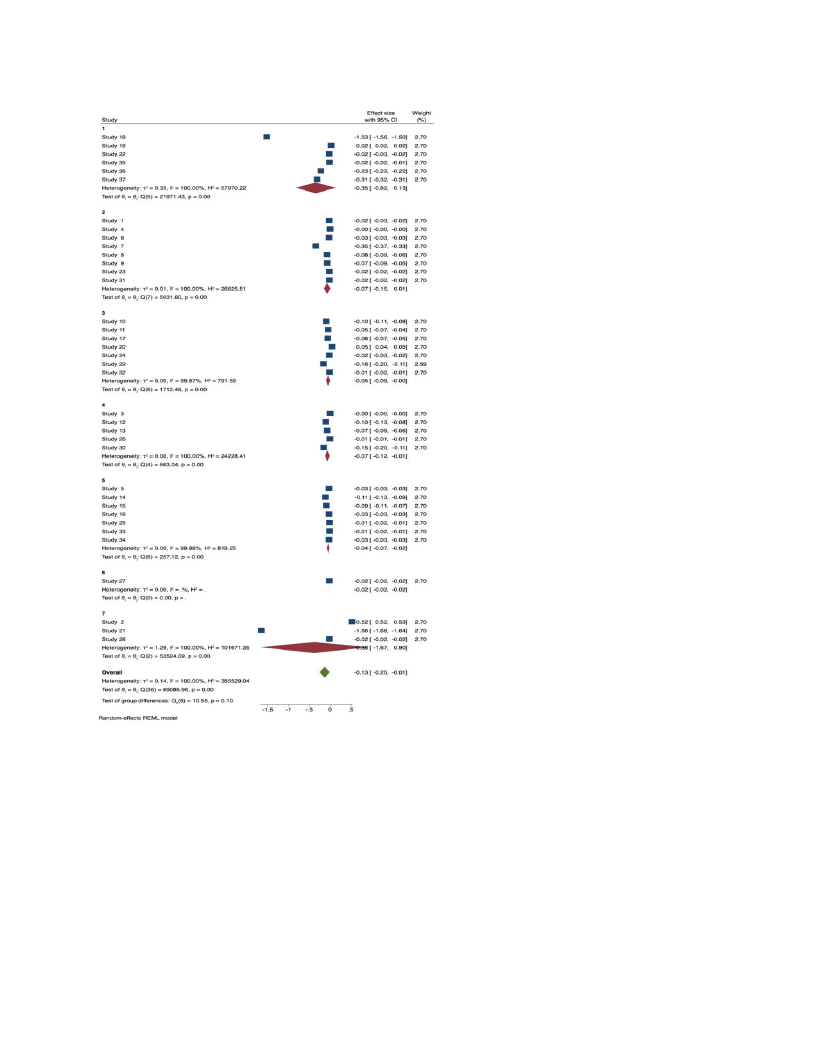
Moderating Analysis
We conducted a meta regression to assess for moderating influences from spatial and
temporal measurement design and geographical region. Due to small sample size, we could not
assess the impact of all moderating factors simultaneously. Variations in geography, temporality
of air pollution measurement also could not be computed individually due to low sample size.
26

Heterogeneity Assessment
Heterogeneity is a measure of inconsistency across the study findings (Borenstein et al.,
2021). We examined heterogeneity using subgroup meta-regression. Specifically, we checked
whether spatial or temporal measurement or geographical region accounted for heterogeneity.
Geographically, North America had the most heterogeneous results (h2 = 940,000, I2 = 100%),
followed up Europe (h2 = 640,000, I2 = 100%), Asia (h2 =18684, I2 = 99.99%), and South
America (h2 = 48.59, I2 = 97.94%). Overall, controlling for geographical heterogeneity reduced
overall heterogeneity by as much as 2%, with studies in South America having the lowest
heterogeneity. Spatially, measurement at the regional level had the most heterogeneous results
(h2 = 1,300, I2 = 100%) followed by city level (h2 = 1506.65, I2 = 99.93%), and finally
individual level (h2 = 136.92, I2 = 99.27%) Overall, controlling for spatial characteristics
reduced overall heterogeneity by as much as .07%, with air pollution exposure measured at the
individual level having the lowest heterogeneity. Temporally, well-being measurement
associated with quarterly measurement of air pollution had the highest heterogeneity (h2 =
150,000, I2 = 100%) followed by daily measurement (h2 = 130,000, I2 = 100%) and annual
measurement (h2 = 97,613, I2 = 100%) Overall, controlling for temporal characteristics reduced
overall heterogeneity did not reduce heterogeneity. Despite attempts to control for study
heterogeneity, no study characteristics accounted for enough variance in measurement to reduce
heterogeneity to an appropriate level (Borenstein et al., 2021). Therefore, study results likely do
not reflect the true relationship between ambient air pollution and life satisfaction. Hypotheses 1
through 4 could not be accepted or rejected due to broad heterogeneity. Heterogeneity may also
27

be a result of true differences in study population effects rather than due to differences in
measurement design as tau was large (T =.096), and thus the well-being of different populations
may be impacted differently by air pollution. Due to this fact, the discussion section will focus
on how to make studies amenable to better measurement in order to make a future meta-analysis
possible.
Publication Bias
To assess for publication bias we used a funnel plot (Stata command: Metafunnel). The
funnel plot showed substantial asymmetry, which may suggest publication bias although
asymmetry may also be a result of measurement or true heterogeneity (see figure two) (Stuck et
al., 1998; Tang & Liu, 2000). Given the broad heterogeneity of the study results, analysis of
study bias is unwarranted, thus it is unclear whether publication bias impacted the results of this
meta regression.
Figure 4. Funnel Plot
28
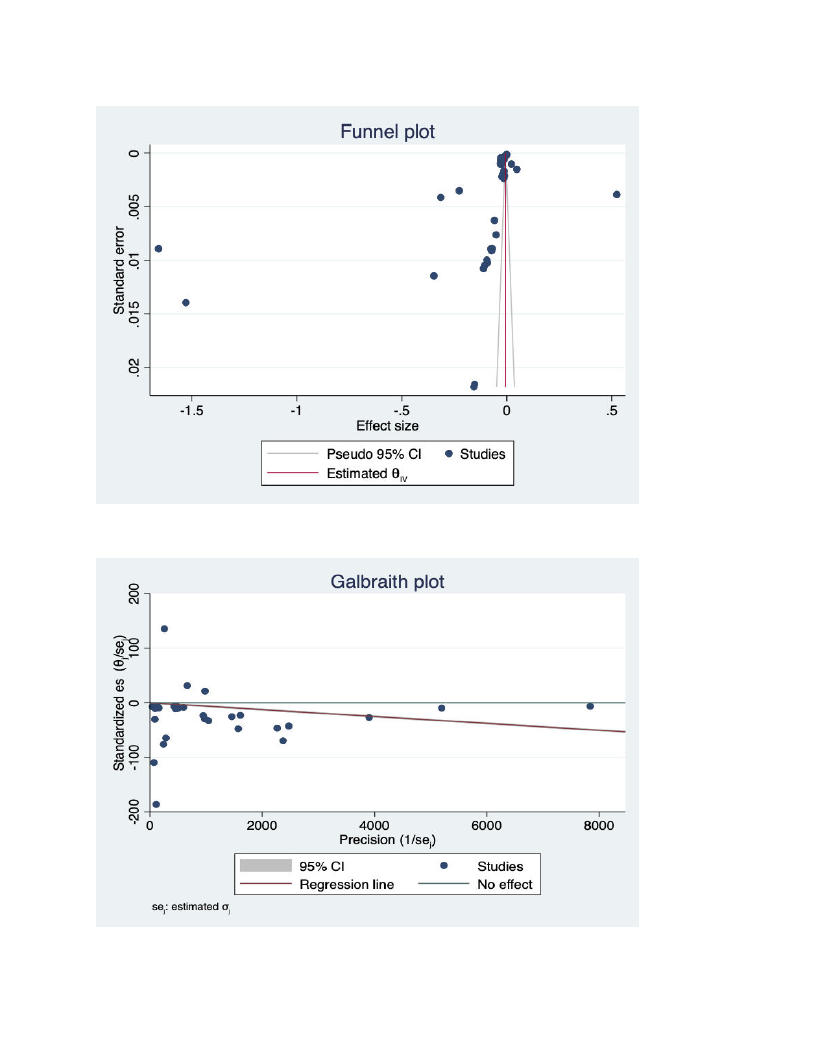
Figure 5. Galbraith Plot
29

Discussion
We conducted a meta-analysis (n = 17) to assess the relationship between subjective
reports of life satisfaction and objective exposure to ambient air pollution. Results from our
analysis indicate that there may be no significant relationship between these two variables across
studies, although our results are largely inconclusive due to high heterogeneity and poor study
design. These findings are contrary to our original hypotheses as we expected to find a
significant relationship between air pollution and well-being.
In our analysis of heterogeneity, only measuring pollution exposure on the individual
level began to reduce heterogeneity. This finding is important, because it indicates that many
studies may not be assessing air pollution exposure with enough specificity, particularly given
that amounts of exposure can vary significantly even across small geographical areas.
A second reason for high heterogeneity in our models may be a result of not controlling
for subjective perceptions on air pollution exposure. There is ample research support that
negative perceptions of air pollution impact the relationship between objective exposure to
pollutants and well-being impact (Li & Zhou, 2020). The studies in our analysis did not control
for subjective perceptions of exposure, which may help explain the wide variability in findings.
High heterogeneity may also be explained by subjective well-being measurement. As
noted previously, all but one of our studies used a single item life satisfaction measure, often
couched within a larger social survey. Some research has indicated that single item well-being
measures have good psychometric properties; however, individuals in diverse cultures may
answer these questionnaires differently and single item measures prevent deeper analysis of the
30

well-being construct (Diamantopoulos et al., 2012)). Specifically, individuals may rate their life
satisfaction higher or lower for different reasons and given the small effect sizes in ecological
well-being research, these differences in responses may increase the heterogeneity across studies
(Tov & Nai, 2018). Given the lack of multi-item measures included in current research,
adequately assessing how well-being measurement impacts heterogeneity is not possible at this
time.
Limitations
In addition to challenges with high heterogeneity, our research was also limited in several
other ways. First of all, we only focused on meta-regression research due to a lack of studies
with more complex study designs. This limitation limits the interpretability and generalizability
of our results as we cannot compute an overall effect size or odds ratio. Multiple regression cross
sectional study designs do not allow for complex understanding of the hierarchical relationships
between variables. Therefore, our use of beta-coefficients limits the interpretability of our
results.
Second, our study only focused on life-satisfaction as a measure of subjective well-being.
We used life satisfaction to measure well-being because the majority of the research in this area
has been done using life satisfaction measures, and because hedonic well-being measures have
been shown to introduce bias into analysis. However, subjective well-being may be
conceptualized more broadly than satisfaction with life. Other components of subjective well-
being include present moment positive emotions, satisfaction with physical health, satisfaction
with relationships, quality of life, and satisfaction with meaning and significance of life. Air
31

pollution may influence these well-being areas differently, and therefore this study cannot make
claims about the influence of air pollution on subjective well-being as a whole.
Future research
Future research on this topic should involve enhanced measurement, more complex study
design, and better accounting of confounding variables. The goal of air pollution and well-being
research in the first place is to assess how air pollution is actually impacting quality of life, yet
current research does not have specificity or the complexity to actually understand the
relationship between these variables. By enhancing complexity and specificity, future meta-
analyses will be able to understand whether variability in results a result of true heterogeneity is
actually or simply measurement error.
Methods have already been developed that will vastly improve the quality of air pollution
and well-being measurement, however they are currently not being employed. In the last couple
years, researchers have developed wearable air pollution trackers that are both accurate and cost
effective (Park, 2021; Park et al., 2021). Future research could have participants wear these
trackers for several months and measure subjective well-being at multiple time points. This
research would allow for better understanding of individual exposure to air pollution over time
and allow for more accurate assessment of the relationship between air pollution and well-being.
Well-being measurement can be improved by using multi-faceted well-being measure such as the
one used by (Smyth et al., 2011). Increasing measurement quality will greatly enhance future
research and will allow for more specific measurement of the impact of air pollution on well-
being.
32

Future research should also focus most explicitly on more complex statistical models
assessing well-being and air pollution including hierarchical and SEM approaches. This research
has already been started by Li & Zhou (2020), who have illustrated the hierarchical relationships
between variables that influence air pollution and well-being in China. More research like this
will allow meta-analyses of complex statistical models, which will likely help reduce
heterogeneity and better analyze variance between populations. For example, research in this
area may indicate an interstudy effect of age on air pollution perceptions and physical health
problems that leads to decreased subjective well-being, alternatively this research may
demonstrate a nonsignificant relationship across studies as indicated in our research. More
complexity in future models will allow for more comprehensive analysis and a better
understanding of the relationships between air pollution and well-being.
Future research should also include both perceptions of air pollution exposure and
objective measurements of pollutants. Adding perceptions to statistical models will help limit
heterogeneity. Completing a meta-analytic review assessing the specific effect of air pollution
perceptions on well-being will help provide a quantitative analysis of this area of research.
Perceptions are particularly important when analyzing impact on subjective reports of well-
being, as individuals’ who do not view air pollution as a health risk are unlikely to account for it
when assessing their satisfaction with life.
Conclusion
Prior research on subjective well-being and ambient air pollution has indicated that there
is a negative effect between increased ambient air pollution exposure and psychological well-
33

being. Our paper sought to assess the magnitude of this relationship across studies, specifically
focusing on the relationship between a standardized increase in air pollution and a standardized
change in life satisfaction. Our analysis indicated a nonsignificant relationship between these two
variables and did not find that this relationship was mediated by pollutant type, geographical
location of study, or temporal or spatial specificity of air pollution exposure. Our study,
however, had significant heterogeneity (>99%) that severely limited the interpretability of our
findings.
Ultimately the goal of studying air pollution and well-being is to improve quality of life.
Yet the current research does not provide clear answers on the relationship between these two
constructs. Thus far we know that the effect of air pollution on well-being varies significantly
between studies. However, this may be a result of either real differences in the subjective
experience of air pollution exposure, measurement error, or a combination of the two. Separating
measurement error from real variation should be the goal of future research, because at this point
the quality of the literature does not offer definitive conclusions.
Understanding the overall impact of air pollution on well-being may require nuance
because populations differ in their perceptions about air pollution, and some populations may
adapt to higher pollution differently than others. Given that the ultimate goal of this research is
understanding how well-being is impacted by a complex ecological environment, seeking to find
universal dollar amounts or effect sizes for the relationship between these variables may be less
productive than understanding the hierarchical relationships and mechanisms of change.
Measuring mechanisms of change such as air pollution perception or impact on physical health
34

will provide more fruitful areas for intervention, rather than simply quantifying the size of the
relationship between variables.
Properly understanding mechanisms of change will require examining the constructs with
enough specificity and complexity to actually understand how specific communities are being
impacted. We hope our systematic review and assessment of heterogeneity will help provide a
pathway to future successful meta-analytic and experimental research in this area. With more
complex study designs and better measurement, future research will be able to better
conceptualize the relationship between well-being and air pollution, and hopefully provide
pathways for higher quality of life.
35

References
Adler, A., & Seligman, M. E. P. (2016). Using wellbeing for public policy: Theory,
measurement, and recommendations. International Journal of Wellbeing, 6(1), Article 1.
https://doi.org/10.5502/ijw.v6i1.429
Ahumada, G., & Iturra, V. (2021). If the air was cleaner, would we be happier? An economic
assessment of the effects of air pollution on individual subjective well-being in Chile.
Journal of Cleaner Production, 289, 125152.
https://doi.org/10.1016/j.jclepro.2020.125152
Almetwally, A. A., Bin-Jumah, M., & Allam, A. A. (2020). Ambient air pollution and its
influence on human health and welfare: An overview. Environmental Science and
Pollution Research, 27(20), 24815–24830. https://doi.org/10.1007/s11356-020-09042-2
An, R., Zhang, S., Ji, M., & Guan, C. (2018). Impact of ambient air pollution on physical activity
among adults: A systematic review and meta-analysis. Perspectives in Public Health,
138(2), 111–121. https://doi.org/10.1177/1757913917726567
Assembly, G. (2015). Resolution adopted by the General Assembly on 11 September 2015.
A/RES/69/315 15 September 2015. New York: United Nations. https://www. unescwa.
org/sites/www. unescwa. org/files/un_resolutions/a_res_69_315_e. pdf.
Baldwin, S. A., & Shadish, W. R. (2011). A primer on meta-analysis in clinical psychology.
Journal of Experimental Psychopathology, 2(2), 294–317.
https://doi.org/10.5127/jep.009610
Barrington-Leigh, C., & Behzadnejad, F. (2017). Evaluating the short-term cost of low-level
local air pollution: A life satisfaction approach. Environmental Economics and Policy
Studies, 19(2), 269–298. https://doi.org/10.1007/s10018-016-0152-7
35

Berry, H. L., Waite, T. D., Dear, K. B. G., Capon, A. G., & Murray, V. (2018). The case for
systems thinking about climate change and mental health. Nature Climate Change, 8(4),
282–290. https://doi.org/10.1038/s41558-018-0102-4
Borenstein, M., Hedges, L. V., Higgins, J. P. T., & Rothstein, H. R. (2021). Introduction to meta-
analysis. John Wiley & Sons.
Braithwaite, I., Zhang, S., Kirkbride, J. B., Osborn, D. P. J., & Hayes, J. F. (2019). Air pollution
(particulate matter) exposure and associations with depression, anxiety, bipolar,
Psychosis and suicide risk: A systematic review and meta-analysis. Environmental
Health Perspectives, 127(12), 126002. https://doi.org/10.1289/EHP4595
Bryndin, E. (2017). Healthy wellbeing of the person and society. 130–139.
https://doi.org/10.15405/epsbs.2017.01.17
Buoli, M., Grassi, S., Caldiroli, A., Carnevali, G. S., Mucci, F., Iodice, S., Cantone, L., Pergoli,
L., & Bollati, V. (2018). Is there a link between air pollution and mental disorders?
Environment International, 118, 154–168. https://doi.org/10.1016/j.envint.2018.05.044
Burnett, R., Chen, H., Szyszkowicz, M., Fann, N., Hubbell, B., Pope, C. A., Apte, J. S., Brauer,
M., Cohen, A., Weichenthal, S., Coggins, J., Di, Q., Brunekreef, B., Frostad, J., Lim, S.
S., Kan, H., Walker, K. D., Thurston, G. D., Hayes, R. B., … Spadaro, J. V. (2018).
Global estimates of mortality associated with long-term exposure to outdoor fine
particulate matter. Proceedings of the National Academy of Sciences of the United States
of America, 115(38), 9592–9597.
Calderón-Garcidueñas, L., Calderón-Garcidueñas, A., Torres-Jardón, R., Avila-Ramírez, J.,
Kulesza, R. J., & Angiulli, A. D. (2015). Air pollution and your brain: What do you need
to know right now. Primary Health Care Research & Development, 16(4), 329–345.
36

https://doi.org/10.1017/S146342361400036X
Chang, P.-J., Song, R., & Lin, Y. (2019). Air pollution as a moderator in the association between
leisure activities and well-being in urban China. Journal of Happiness Studies, 20(8),
2401–2430. https://doi.org/10.1007/s10902-018-0055-3
Chen, S., Qin, P., Tan-Soo, J.-S., & Wei, C. (2019). Recency and projection biases in air quality
valuation by Chinese residents. Science of The Total Environment, 648, 618–630.
https://doi.org/10.1016/j.scitotenv.2018.08.153
Cheung, F., & Lucas, R. E. (2014). Assessing the validity of single-item life satisfaction
measures: results from three large samples. Quality of Life Research: An International
Journal of Quality of Life Aspects of Treatment, Care and Rehabilitation, 23(10), 2809–
2818. https://doi.org/10.1007/s11136-014-0726-4
Cooke, P. J., Melchert, T. P., & Connor, K. (2016). Measuring well-being: A review of
instruments. The Counseling Psychologist, 44(5), 730–757.
https://doi.org/10.1177/0011000016633507
Diamantopoulos, A., Sarstedt, M., Fuchs, C., Wilczynski, P., & Kaiser, S. (2012). Guidelines for
choosing between multi-item and single-item scales for construct measurement: A
predictive validity perspective. Journal of the Academy of Marketing Science, 40(3),
434–449. https://doi.org/10.1007/s11747-011-0300-3
Diener, E., Lucas, R., & Oishi, S. (2018). Advances and Open Questions in the Science of
Subjective Well-Being | Collabra: Psychology | University of California Press. Collabra:
Psychology. https://online.ucpress.edu/collabra/article/4/1/15/112974/Advances-and-
Open-Questions-in-the-Science-of
Dolan, P., & Laffan, K. (2016). Bad air days: The effects of air quality on different measures of
37

subjective well-being. Journal of Benefit-Cost Analysis, 7(1), 147–195.
https://doi.org/10.1017/bca.2016.7
Dong, G., Nakaya, T., & Brunsdon, C. (2018). Geographically weighted regression models for
ordinal categorical response variables: An application to geo-referenced life satisfaction
data. Computers, Environment and Urban Systems, 70, 35–42.
https://doi.org/10.1016/j.compenvurbsys.2018.01.012
Drukker, M., Weltens, I., van Hooijdonk, C. F. M., Vandenberk, E., & Bak, M. (2021).
Development of a methodological quality criteria list for observational studies: The
observational study quality evaluation. Frontiers in Research Metrics and Analytics, 6.
https://www.frontiersin.org/article/10.3389/frma.2021.675071
Du, G., Shin, K. J., & Managi, S. (2018). Variability in impact of air pollution on subjective
well-being. Atmospheric Environment, 183, 175–208.
https://doi.org/10.1016/j.atmosenv.2018.04.018
Errigo, I. M., Abbott, B. W., Mendoza, D. L., Mitchell, L., Sayedi, S. S., Glenn, J., Kelly, K. E.,
Beard, J. D., Bratsman, S., Carter, T., Chaney, R. A., Follett, A., Freeman, A., Frei, R. J.,
Greenhalgh, M., Holmes, H. A., Howe, P. D., Johnston, J. D., Lange, L., … Wilson, D.
(2020). Human health and economic costs of air pollution in Utah: An expert assessment.
Atmosphere, 11(11), 1238. https://doi.org/10.3390/atmos11111238
Faustini, A., Rapp, R., & Forastiere, F. (2014). Nitrogen dioxide and mortality: Review and
meta-analysis of long-term studies. European Respiratory Journal, 44(3), 744–753.
https://doi.org/10.1183/09031936.00114713
Ferreira, S., & Moro, M. (2010). On the use of subjective well-being data for environmental
valuation. Environmental and Resource Economics, 46(3), 249–273.
38

https://doi.org/10.1007/s10640-009-9339-8
Ferrer-i-Carbonell, A., & Gowdy, J. M. (2007). Environmental degradation and happiness.
Ecological Economics, 60(3), 509–516. https://doi.org/10.1016/j.ecolecon.2005.12.005
Goetzke F, Rave T. Regional air quality and happiness in Germany. International Regional
Science Review. 2015;38(4):437-451. doi:10.1177/0160017615589008
Gu, H., Yan, W., Elahi, E., & Cao, Y. (2020). Air pollution risks human mental health: An
implication of two-stages least squares estimation of interaction effects. Environmental
Science and Pollution Research, 27(2), 2036–2043. https://doi.org/10.1007/s11356-019-
06612-x
Guo, W., Chen, L., Fan, Y., Liu, M., & Jiang, F. (2021). Effect of ambient air quality on
subjective well-being among Chinese working adults. Journal of Cleaner Production,
296, 126509. https://doi.org/10.1016/j.jclepro.2021.126509
Harbord, R. M., & Higgins, J. P. T. (2008). Meta-Regression in Stata. The Stata Journal:
Promoting Communications on Statistics and Stata, 8(4), 493–519.
https://doi.org/10.1177/1536867X0800800403
Hart, E. A. C., Lakerveld, J., McKee, M., Oppert, J.-M., Rutter, H., Charreire, H., Veenhoven,
R., Bárdos, H., Compernolle, S., Bourdeaudhuij, I. D., Brug, J., & Mackenbach, J. D.
(2018). Contextual correlates of happiness in European adults. PLOS ONE, 13(1),
e0190387. https://doi.org/10.1371/journal.pone.0190387
Hedges, L. V., Tipton, E., & Johnson, M. C. (2010). Robust variance estimation in meta-
regression with dependent effect size estimates. Research Synthesis Methods, 1(1), 39–
65. https://doi.org/10.1002/jrsm.5
39

Henderson, L. W., & Knight, T. (2012). Integrating the hedonic and eudaimonic perspectives to
more comprehensively understand wellbeing and pathways to wellbeing. International
Journal of Wellbeing, 2(3), 196–221. https://doi.org/10.5502/ijw.v2i3.3
Huang, P. H. (2018). Subjective Well-Being and the Law (SSRN Scholarly Paper ID 3366600).
Social Science Research Network. https://papers.ssrn.com/abstract=3366600
Kahneman, D., Krueger, A. B., Schkade, D., Schwarz, N., & Stone, A. (2004). Toward national
well-being accounts. American Economic Review, 94(2), 429–434.
https://doi.org/10.1257/0002828041301713
Kim, K.-H., Jahan, S. A., & Kabir, E. (2013). A review on human health perspective of air
pollution with respect to allergies and asthma. Environment International, 59, 41–52.
https://doi.org/10.1016/j.envint.2013.05.007
Klausen, S. H., Emiliussen, J., Christiansen, R., Hasandedic-Dapo, L., & Engelsen, S. (2021).
The many faces of hedonic adaptation. Philosophical Psychology, 0(0), 1–26.
https://doi.org/10.1080/09515089.2021.1967308
Lee, D. K., In, J., & Lee, S. (2015). Standard deviation and standard error of the mean. Korean
Journal of Anesthesiology, 68(3), 220–223. https://doi.org/10.4097/kjae.2015.68.3.220
Lelieveld, J., Klingmüller, K., Pozzer, A., Pöschl, U., Fnais, M., Daiber, A., & Münzel, T.
(2019). Cardiovascular disease burden from ambient air pollution in Europe reassessed
using novel hazard ratio functions. European Heart Journal, 40(20), 1590–1596.
https://doi.org/10.1093/eurheartj/ehz135
Li, F., & Zhou, T. (2020). Effects of objective and subjective environmental pollution on well-
being in urban China: A structural equation model approach. Social Science & Medicine,
249, 112859. https://doi.org/10.1016/j.socscimed.2020.112859
40

Li, Y., Guan, D., Tao, S., Wang, X., & He, K. (2018). A review of air pollution impact on
subjective well-being: Survey versus visual psychophysics. Journal of Cleaner
Production, 184, 959–968. https://doi.org/10.1016/j.jclepro.2018.02.296
Liu, H., & Hu, T. (2021). How does air quality affect residents’ life satisfaction? Evidence based
on multiperiod follow-up survey data of 122 cities in China. Environmental Science and
Pollution Research, 28(43), 61047–61060. https://doi.org/10.1007/s11356-021-15022-x
Lomas, T. (2015). Positive social psychology: A multilevel inquiry into sociocultural well-being
initiatives. Psychology, Public Policy, and Law, 21(3), 338–347.
https://doi.org/10.1037/law0000051
Lu, J. G. (2020). Air pollution: A systematic review of its psychological, economic, and social
effects. Current Opinion in Psychology, 32, 52–65.
https://doi.org/10.1016/j.copsyc.2019.06.024
Luechinger, S. (2009). Valuing air quality using the Life Satisfaction Approach. The Economic
Journal, 119(536), 482–515. https://doi.org/10.1111/j.1468-0297.2008.02241.x
Luechinger, S. (2010). Life satisfaction and transboundary air pollution. Economics Letters,
107(1), 4–6. https://doi.org/10.1016/j.econlet.2009.07.007
MacKerron, G., & Mourato, S. (2009). Life satisfaction and air quality in London. Ecological
Economics, 68(5), 1441–1453. https://doi.org/10.1016/j.ecolecon.2008.10.004
Martín-María, N., Miret, M., Caballero, F. F., Rico-Uribe, L. A., Steptoe, A., Chatterji, S., &
Ayuso-Mateos, J. L. (2017). The impact of subjective well-being on mortality: A meta-
analysis of longitudinal studies in the general population. Psychosomatic Medicine,
79(5), 565–575. https://doi.org/10.1097/PSY.0000000000000444
Mendoza, Y., Loyola, R., Aguilar, A., & Escalante, R. (2019). Valuation of air quality in Chile:
41

The life satisfaction approach. Social Indicators Research, 145(1), 367–387.
https://doi.org/10.1007/s11205-019-02103-1
Meng, Z., Qin, G., Zhang, B., Geng, H., Bai, Q., Bai, W., & Liu, C. (2003). Oxidative damage of
sulfur dioxide inhalation on lungs and hearts of mice. Environmental Research, 93(3),
285–292. https://doi.org/10.1016/S0013-9351(03)00045-8
Menz, T. (2011). Do people habituate to air pollution? Evidence from international life
satisfaction data. Ecological Economics, 71, 211–219.
https://doi.org/10.1016/j.ecolecon.2011.09.012
Menz, T., & Welsch, H. (2012). Life-cycle and cohort effects in the valuation of air quality:
Evidence from subjective well-being data. Land Economics, 88(2), 300–325.
https://doi.org/10.3368/le.88.2.300
Nurse, J., Basher, D., Bone, A., & Bird, W. (2010). An ecological approach to promoting
population mental health and well-being — a response to the challenge of climate
change. Perspectives in Public Health, 130(1), 27–33.
https://doi.org/10.1177/1757913909355221
Odermatt, R., & Stutzer, A. (2017). Subjective well-being and public policy. SSRN Electronic
Journal. https://doi.org/10.2139/ssrn.3069445
Page, M. J., McKenzie, J. E., Bossuyt, P. M., Boutron, I., Hoffmann, T. C., Mulrow, C. D.,
Shamseer, L., Tetzlaff, J. M., Akl, E. A., Brennan, S. E., Chou, R., Glanville, J.,
Grimshaw, J. M., Hróbjartsson, A., Lalu, M. M., Li, T., Loder, E. W., Mayo-Wilson, E.,
McDonald, S., … Moher, D. (2021). The PRISMA 2020 statement: An updated guideline
for reporting systematic reviews. BMJ, 372, n71. https://doi.org/10.1136/bmj.n71
Palmer, T. M., & Sterne, J. A. C. (2016). Meta-Analysis in Stata: An Updated Collection from
42

the Stata Journal, Second Edition [Stata Press books]. StataCorp LP.
https://econpapers.repec.org/bookchap/tsjspbook/mais.htm
Park, Y. M. (2021). A GPS-enabled portable air pollution sensor and web-mapping technologies
for field-based learning in health geography. Journal of Geography in Higher Education,
0(0), 1–21. https://doi.org/10.1080/03098265.2021.1900083
Park, Y. M., Sousan, S., Streuber, D., & Zhao, K. (2021). GeoAir—A novel portable, GPS-
enabled, low-cost air-pollution sensor: Design strategies to facilitate citizen science
research and geospatial assessments of personal exposure. Sensors, 21(11), 3761.
https://doi.org/10.3390/s21113761
Perez-Truglia, R. (2012). On the causes and consequences of hedonic adaptation. Journal of
Economic Psychology, 33(6), 1182–1192. https://doi.org/10.1016/j.joep.2012.08.004
Polivka, B. J. (2018). The great London smog of 1952. AJN The American Journal of Nursing,
118(4), 57–61. https://doi.org/10.1097/01.NAJ.0000532078.72372.c3
Proto, E., & Rustichini, A. (2013). A reassessment of the relationship between GDP and life
satisfaction. PLOS ONE, 8(11), e79358. https://doi.org/10.1371/journal.pone.0079358
Robertson, D. S. (2006). Health effects of increase in concentration of carbon dioxide in the
atmosphere. Current Science, 90(12), 1607–1609.
Romanelli, C., Cooper, D., Campbell-Lendrum, D., Maiero, M., Karesh, W. B., Hunter, D., &
Golden, C. D. (2015). Connecting global priorities: Biodiversity and human health: A
state of knowledge review. World Health Organization/Secretariat of the UN Convention
on Biological Diversity. https://cgspace.cgiar.org/handle/10568/67397
Rotko, T., Oglesby, L., Künzli, N., Carrer, P., Nieuwenhuijsen, M. J., & Jantunen, M. (2002).
Determinants of perceived air pollution annoyance and association between annoyance
43

scores and air pollution (PM2.5, NO2) concentrations in the European EXPOLIS study.
Atmospheric Environment, 36(29), 4593–4602. https://doi.org/10.1016/S1352-
2310(02)00465-X
Schiavo, J. H. (2019). PROSPERO: An international register of systematic review protocols.
Medical Reference Services Quarterly, 38(2), 171–180.
https://doi.org/10.1080/02763869.2019.1588072
Schmitt, M. (2013). Subjective well-being and air quality in Germany. SSRN Electronic Journal.
https://doi.org/10.2139/ssrn.2228091
Shi, D., & Yu, H. (2020). Reevaluating the subjective welfare loss of air pollution. Journal of
Cleaner Production, 257, 120445. https://doi.org/10.1016/j.jclepro.2020.120445
Smyth, R., Nielsen, I., Zhai, Q., Liu, T., Liu, Y., Tang, C., Wang, Z., Wang, Z., & Zhang, J.
(2011). A study of the impact of environmental surroundings on personal well-being in
urban China using a multi-item well-being indicator. Population and Environment, 32(4),
353–375. https://doi.org/10.1007/s11111-010-0123-z
Stern, A. C., & Professor, E. (1982). History of air pollution legislation in the United States.
Journal of the Air Pollution Control Association, 32(1), 44–61.
https://doi.org/10.1080/00022470.1982.10465369
Stuck, A. E., Rubenstein, L. Z., Wieland, D., Vandenbroucke, J. P., Irwig, L., Macaskill, P.,
Berry, G., Glasziou, P., Seagroatt, V., Stratton, I., Egger, M., Smith, G. D., Minder, C.,
Langhorne, P., Song, F., & Gilbody, S. (1998). Bias in meta-analysis detected by a
simple, graphical test. BMJ: British Medical Journal, 316(7129), 469–471.
Tainio, M., Jovanovic Andersen, Z., Nieuwenhuijsen, M. J., Hu, L., de Nazelle, A., An, R.,
Garcia, L. M. T., Goenka, S., Zapata-Diomedi, B., Bull, F., & Sá, T. H. de. (2021). Air
44

pollution, physical activity and health: A mapping review of the evidence. Environment
International, 147, 105954. https://doi.org/10.1016/j.envint.2020.105954
Tang, J.-L., & Liu, J. L. (2000). Misleading funnel plot for detection of bias in meta-analysis.
Journal of Clinical Epidemiology, 53(5), 477–484. https://doi.org/10.1016/S0895-
4356(99)00204-8
Tov, W., & Nai, Z. L. S. (2018). Cultural differences in subjective well-being: How and why. In
Subjective well-being and life satisfaction (pp. 50–73). Routledge/Taylor & Francis
Group.
Turner, B. S. (2018). (I can’t get no) satisfaction: Happiness and successful societies. Journal of
Sociology, 54(3), 279–293. https://doi.org/10.1177/1440783318774858
Wang, R., Yang, B., Yao, Y., Bloom, M. S., Feng, Z., Yuan, Y., Zhang, J., Liu, P., Wu, W., Lu,
Y., Baranyi, G., Wu, R., Liu, Y., & Dong, G. (2020). Residential greenness, air pollution
and psychological well-being among urban residents in Guangzhou, China. Science of
The Total Environment, 711, 134843. https://doi.org/10.1016/j.scitotenv.2019.134843
Welsch, H. (2002). Preferences over prosperity and pollution: Environmental valuation based on
happiness surveys. Kyklos, 55(4), 473–494. https://doi.org/10.1111/1467-6435.00198
World Health Organization. (2014). 7 million premature deaths annually linked to air pollution.
World Health Organization. Retrieved April 15, 2022, from
https://www.who.int/news/item/25-03-2014-7-million-premature-deaths-annually-linked-
to-air-pollution
Yang, Z., Song, Q., Li, J., Zhang, Y., Yuan, X.-C., Wang, W., & Yu, Q. (2021). Air pollution
and mental health: The moderator effect of health behaviors. Environmental Research
Letters, 16(4), 044005. https://doi.org/10.1088/1748-9326/abe88f
45

Yuan, L., Shin, K., & Managi, S. (2018). Subjective well-being and environmental quality: The
impact of air pollution and green coverage in China. Ecological Economics, 153, 124–
138. https://doi.org/10.1016/j.ecolecon.2018.04.033
46
